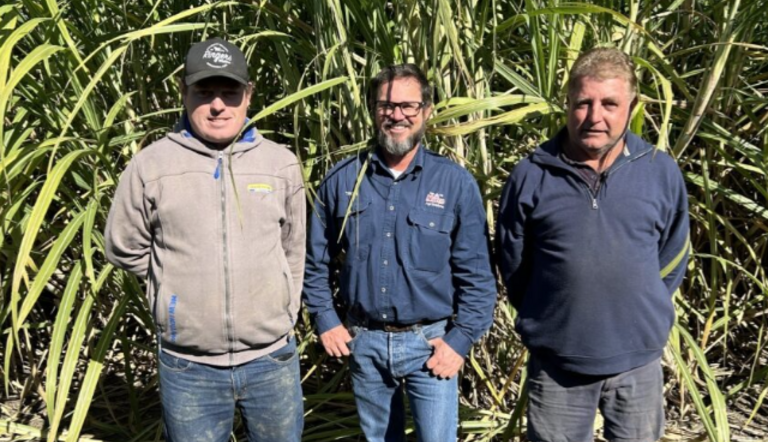
Longer weed control a big win for cane growers

Norco Agrisolutions Grafton-based agronomist Trent Stainley (centre) with Lawrence sugarcane growers Jake and Rex Green, Northern New South Wales. Rex says adding Bobcat i-Maxx herbicide to their weed management program has improved the length of control.
ACHIEVING season-long control of grass and broadleaf weeds in sugarcane crops is a constant challenge, however strategic herbicide applications and wider management is helping various Northern New South Wales growers to get the upper hand in the battle.
For Lawrence grower Rex Green, adding Bobcat® i-MAXX herbicide to his weed management program in sugarcane has helped to improve the length of weed control and, hence, potentially reduce applications.
Bobcat i-MAXX, also from ADAMA Australia and with no time of use restrictions, combines the strengths of hexazinone and imazapic active ingredients for excellent knockdown and extended residual control, as well as providing important resistance management benefits.
Rex and his sons, Jake and Greg, crop around 260 hectares to cane alongside the Clarence River, located near Yamba in Northern New South Wales. The Green family has farmed there since the 1880s, progressing from dairying and mixed crops production to predominantly cane, whilst also running a few cattle.
Summer grasses, crab grass and pink bindweed are some of the major targets for the Greens on their properties.
“Keeping the pink convolvulus under control is important because they can grow up through the cane and pull it down,” Rex said.
Excellent weed control in plant cane at the Green’s Lawrence property following application of Bobcat i-MAXX at 530 grams per hectare at the out-of-hand stage.
Trent Stainley, Agronomist with Norco Agrisolutions at Grafton, supports the family’s herbicide decision-making, which has centred on using a diverse mix of herbicides.
Significant areas of plant cane are treated with metolachlor, while Bobcat i-MAXX has been used in recent times at the out-of-hand stage, replacing applications of isoxaflutole. Prior to that, diuron, atrazine and paraquat herbicides were used.
“We are using Bobcat i-Maxx because we get such great, long control, and we add some paraquat with it to burn weeds off that have emerged,” Rex said.
“We are also using Bobcat i-Maxx with later ratoons, where we might only have one application with fertiliser. We can cut in November and then hit it for one-pass weed control and fertilising.”
For further information on Palmero TX and Bobcat i-MAXX herbicides, growers and advisers can contact their local ADAMA Australia representative or visit ADAMA.com
Media Contact: Andrew Newall | Portfolio and Innovation Manager | Andrew.newall@adama.com | +61 418 224 422